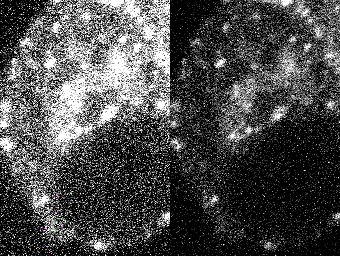| Author: | Christopher Philip Mauer (cpmauer at northwestern.edu) |
| History: |
2003/05/23: First version 2003/07/25: Fixes a bug that caused the first slice of the input stack to be copied to the last slice of the output stack. 2006/11/17: Macro bug fixes by Shannon Stewman (stew at uchicago.edu) 2009/08/05: Works with all image types; filters in place |
| Source: | Kalman_Stack_Filter.java |
| Installation: | Drag and drop Kalman_Stack_Filter.class onto the "ImageJ" window (v1.43 or later). |
| Description: |
This plugin implements a recursive prediction/correction algorithm
which is based on the Kalman Filter (commonly used for robotic vision and
navigation) to remove high gain noise from time lapse image streams.
These filters remove camera/detector noise while recovering faint image detail.
Copyright (C) 2003 CHRISTOPHER PHILIP MAUER Permission to use, copy, modify, and distribute this software for any purpose without fee is hereby granted, provided that this entire notice is included in all copies of any software which is or includes a copy or modification of this software and in all copies of the supporting documentation for such software. Any for profit use of this software is expressly forbidden without first obtaining the explicit consent of the author. THIS SOFTWARE IS BEING PROVIDED "AS IS", WITHOUT ANY EXPRESS OR IMPLIED WARRANTY. IN PARTICULAR, THE AUTHOR DOES NOT MAKE ANY REPRESENTATION OR WARRANTY OF ANY KIND CONCERNING THE MERCHANTABILITY OF THIS SOFTWARE OR ITS FITNESS FOR ANY PARTICULAR PURPOSE. The user can specify:
The filter performs the following steps:
Another version of the filter (
Kalman_Filter.java)
operates in constant memory space by loading each image and storing
the data in memory only as long as it is needed for the computation. The runtime
display consists of two data frames containing the raw and filtered image streams
which are displayed movie-style, and a GUI interface with the ability to adjust the
filter gain and processing/playback rates (on the fly), as well as stop the
procedure and restart. Repeating the filter will apply the learned prediction and
noise models to the initial data.

|